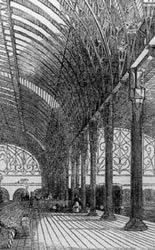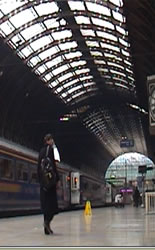Paddington Station
When Brunel designed Paddington Station it was his understanding of engineering which allowed him to come up with such a revolutionary design. To put it simply, he knew which shapes gave materials strength.
The platform was easy, a material like stone or brick could withstand a lot of pressure pushing down on it (compressing it), so with deep foundations it could easily hold the weight of the roof.

The roof was trickier. Brunel chose an arch shaped roof because arches are very strong shapes. The roof was not one arch but 189 wrought-iron arches. They were joined together by longer iron strips running the length of the station. The roof itself was made out of panes of glass, making it much lighter than other stations.
The roof was held up by 69 cast iron pillars. Imagine trying to crush a toilet roll tube by squeezing it from either end. Brunel used a cylinder shape for the pillars because this shape was very strong when compressed, so was perfect for holding up the heavy iron roof.
